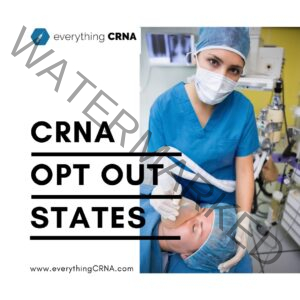 According to the AANA, US Federal law requires that nurse anesthetists must be supervised by a physician when doing their job of providing anesthesia. In November 2001, the Centers for Medicare and Medicaid published a new ruling that individual US States may independently exempt and CRNA opt-out from these federal rules. Since then, many States actively followed suit to become CRNA Opt-Out States. Iowa was the first to opt out of federal physician requirement in December 2001. Then 5 other States (Nebraska, Idaho, Minnesota, New Hampshire) opt out in 2002, another 5 States (Kansas, North Dakota, Washington, Alaska, Oregon) in 2003 and Montana in 2004. This was followed by 2 more CRNA Opt Out States (South Dakota, Wisconsin) in 2005, California in 2009, Colorado in 2010, Kentucky in 2012, Guam in 2016, and Arizona and Oklahoma in 2020.
According to the AANA, US Federal law requires that nurse anesthetists must be supervised by a physician when doing their job of providing anesthesia. In November 2001, the Centers for Medicare and Medicaid published a new ruling that individual US States may independently exempt and CRNA opt-out from these federal rules. Since then, many States actively followed suit to become CRNA Opt-Out States. Iowa was the first to opt out of federal physician requirement in December 2001. Then 5 other States (Nebraska, Idaho, Minnesota, New Hampshire) opt out in 2002, another 5 States (Kansas, North Dakota, Washington, Alaska, Oregon) in 2003 and Montana in 2004. This was followed by 2 more CRNA Opt Out States (South Dakota, Wisconsin) in 2005, California in 2009, Colorado in 2010, Kentucky in 2012, Guam in 2016, and Arizona and Oklahoma in 2020.
In summary, the federal government does not want to be the decision maker and has given deference to the State itself in the Opt-Out decision making process. In order to Opt-Out, the individual States need to fulfill 3 requirements as listed below:
- Opt-Out Requirement #1: The State Board of Medicine and Board of Nursing gives ‘consultation’ to the State governor. This definition of ‘consultation’ was left vague and open to interpretation to be flexible for each State to decide what works best in their given situation.
- Opt-Out Requirement #2: The Opt-Out must be consistent with the State law
- Opt-Out Requirement #3: The Opt-Out must be in the best interest of the citizens of the State. This can be through a letter by the governor of the State.
Which States can CRNAs Practice Independently?
 As of Year 2021, there are now 19 CRNA Opt-Out States and 1 Opt Out US territory which are States that CRNAs can practice independently. These Opt-Out States include
As of Year 2021, there are now 19 CRNA Opt-Out States and 1 Opt Out US territory which are States that CRNAs can practice independently. These Opt-Out States include
- Alaska (opt out in October 2003)
- Arizona (opt out in March 2020)
- California (opt out in July 2009)
- Colorado (opt out in September 2010)
- Iowa (opt out in December 2001)
- Idaho (opt out in March 2002)
- Kansas (opt out in March 2003)
- Kentucky (opt out in April 2012)
- Minnesota (opt out in April 2002)
- Montana (opt out in January 2004)
- Nebraska (opt out in February 2002)
- New Hampshire (opt out in June 2002)
- New Mexico (opt out in November 2002)
- North Dakota (opt out in October 2003)
- Oklahoma CRNA opt out in August 2020)
- Oregon (opt out in December 2003)
- South Dakota (opt out in March 2005)
- Washington (opt out in October 2003)
- Wisconsin (opt out in June 2005)
The US Territory CRNA Opt-Out State is Guam in the Western Pacific. All the CRNA Opt Out States pay very high CRNA Salary, which may explain the additional responsibility and no requirement for a supervisory physician watching over them.
Why CRNA Opt Out States?
 First and mostly importantly, physician supervision of nurse anesthetists has not proven to increase the care and safety of patients. Numerous studies have shown that CRNAs achieve the same level of safety and quality as their physician counterparts. For instance, studies have found anesthesia care to be equally the same with all 3 conditions below:
First and mostly importantly, physician supervision of nurse anesthetists has not proven to increase the care and safety of patients. Numerous studies have shown that CRNAs achieve the same level of safety and quality as their physician counterparts. For instance, studies have found anesthesia care to be equally the same with all 3 conditions below:
- A CRNA working alone
- An anesthesiologist working alone
- A CRNA working under an anesthesiologist
This is the first reason States choose to become CRNA Opt Out States.
Second, the CRNA Opt-Out provides more flexibility, savings and removes the ‘middle-man’ in saving taxpayer and patients money. Many times, nurse anesthetists are the primary ones providing anesthesia for rural neighborhoods in the US. In fact, CRNAs provide millions of Americans in rural areas access to healthcare involving surgical, trauma, pain management anesthesia services. With the requirement of physician supervision before, oftentimes dentists and podiatrists were used. However, they were not relevant and not able to provide significant value-add. At the same time, these ‘supervisors’ did not want to be there with the increased risk of liability.
Thus, without the need of unnecessary supervisors, the patient ends up being the one who benefits with lower medical bills at the end of the day. To clarify, it has been proven in research that Nurse Anesthetist only anesthesia delivery methods are the most cost-effective anesthesia services available. Certainly, with the CRNA Opt-Out, medical centers are able to decide best on the method of quality care for patients in CRNA opt out States.
Recent Status of Nurse Anesthetist Opt-Out States
 Due to the Coronavirus (COVID-19), the president issued temporary regulatory approvals permitting the Centers for Medicare & Medicaid Services, also known as CMS, to allow all States to be Opt Out States during the COVID-19 period. This is the CMS CRNA Opt Out. The goal was to free physicians from the supervisory elements to expand the capacity of both doctors and nurse anesthetists. Overall, medical professionals saw the new approvals very positively and welcomed the increased hospital capacity and expansion of the healthcare workforce quickly.
Due to the Coronavirus (COVID-19), the president issued temporary regulatory approvals permitting the Centers for Medicare & Medicaid Services, also known as CMS, to allow all States to be Opt Out States during the COVID-19 period. This is the CMS CRNA Opt Out. The goal was to free physicians from the supervisory elements to expand the capacity of both doctors and nurse anesthetists. Overall, medical professionals saw the new approvals very positively and welcomed the increased hospital capacity and expansion of the healthcare workforce quickly.
Best CRNA Programs
 We spent hundreds of hours studying all CRNA schools and interviewing over 125 nurse anesthetists to create our exclusive list of Best CRNA Schools. If you’re a CRNA learning about Opt-Out States, please visit the Best CRNA programs and let us know feedback and comments on your CRNA School program to help prospective nurse anesthetist students to support our profession.
We spent hundreds of hours studying all CRNA schools and interviewing over 125 nurse anesthetists to create our exclusive list of Best CRNA Schools. If you’re a CRNA learning about Opt-Out States, please visit the Best CRNA programs and let us know feedback and comments on your CRNA School program to help prospective nurse anesthetist students to support our profession.
The Future of CRNA Opt-Out States
 In the year 2020, the two new CRNA States that opted out of physician supervision of CRNAs were Oklahoma (August 2020) and Arizona (March 2020).
In the year 2020, the two new CRNA States that opted out of physician supervision of CRNAs were Oklahoma (August 2020) and Arizona (March 2020).
I believe eventually, all 50 States in the United States will be CRNA Opt Out States. The COVID-19 temporary regulatory approvals was a great a positive initial step in the right direction. In other words, it gives opportunities for all States to realize the capabilities of nurse anesthetists especially during such a critical time. Time and again, studies have proven that CRNAs-only anesthesia is the most cost effective and safe option available. This will only be cemented further by the new requirements that starting 2025, all CRNA schools will be doctoral degree programs rather than master’s degree programs. Although CRNA Opt Out has taken longer than anyone anticipated, we have been making progress and are working towards the positive trend which will happen eventually.
Do you think all 50 States will eventually be CRNA Opt-Out States? Share your view in the comments below and check out CRNA Salary to learn more about compensation for nurse anesthetists.

